#LatinNovelas
Explore tagged Tumblr posts
Text
The Queering of Latin Novelas
Group #2
Antonio Castaneda, Alexandrea Concepcion, & Namuun Jargalsaikhan
Latin American telenovelas tend to hyper-feminize gay men as well as create a sense of machismo in characters, to create the illusion that being gay means identifying as half a man or an aggressive man to hide their own sexuality. The concept of self rejection is the way in which they make characters exhibit more masculine associated traits, which can cause them to vent and lash out on other characters to make sure they aren’t seen as gay. These two portrayals have the tendency to dictate the portrayals in novelas and latin film. These images all reference characters in novelas that fit these characteristics as well as express characters that could have negative influences on a younger viewer when considering the idea of coming out. On top of that, hyper feminization of gay Latin characters is taken to the max, creating a very inaccurate portrayal of the queer community. In this project, we argue that though we see a larger representation of gay characters in Telenovelas, there’s a prominent pattern of hyper feminization of these gay Latin characters that is harmful because it reinforces false depictions and negative stereotypes.
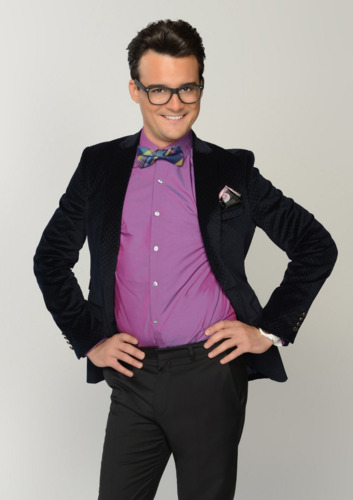
(Rosario "Ro" Flores plays as the gay assistant and faithful consultant of Teresa, he is available to her twenty-four hours of the day in the Telenovela named Marido en Alquiler. He’s very sassy, always wears bright colors, and his behavior is considered dramatic.) (Image Retrieved from Google)
Ro even fits the typical occupation that’s been assigned to so many gay characters within telenovelas—on top of being the gay assistant, he serves as Theresa’s hairdresser. Tate argues, that since the debut of Mexican telenovelas in the mid-twentieth century, the presence of gay male characters for the most part has been limited to the inclusion of effete men who are typically the hair stylists, designers, and/or confidants of the female protagonists or antagonists.” Ro reinforces the ideological idea of hyper feminization of Latin American gay characters in queer television—specifically the “overly glamourized” gay man. In reality, one could easily argue that he projects his image onto his superficially interesting boss.
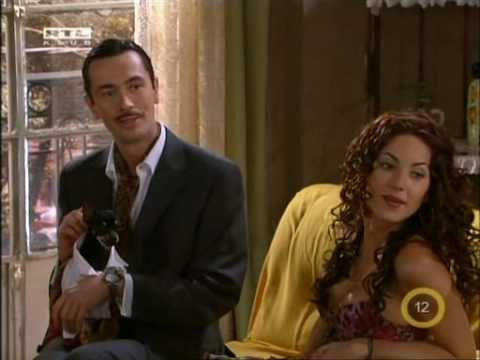
(Scene from an episode where Rubi and Loreto talk about manipulating one of the other characters, Maribel. Loreto can be seen sitting in a more poised position than Rubi. He always carries a lap chihuahua with him, which Rubi comments on, in this scene. Soon after, Loreto sashays across the room, as he makes his dramatic exit.) (Image Retrieved from Google)
Loreto from the telenovela named Rubi also assumes the position of the highly effeminate trusty consultant to the female protagonist, as well as being a high culture fashion designer. He sashays as he walks, he wears a pink handkerchief around his neck, and producers went as far as to incorporate a hand/lap dog who is always in Loreto’s arms. He follows that “gossipy and colorful best friend” theme. Telenovelas often times depict gay men in stereotypical roles which speaks to gender ideologies specifically touching on how the media represents gay Latin character’s attitudes on their place in society. Gay minorities are typically not shown in complex or diverse ways in mainstream media, as touched on by Ciszek. “Many LGBT characters in telenovelas are “relegated to the sidelines,” sending a message to audiences that can lead to marginalizing and trivializing sexual and gender minorities” (Stokes et al., 2016, p. 7), which has evolved into a worrisome trend in Telenovelas.
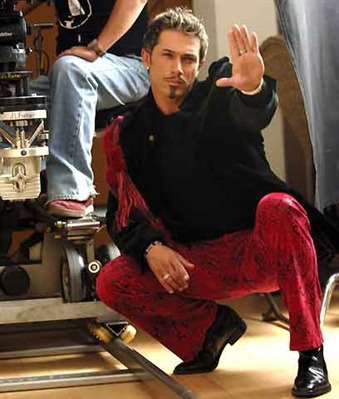
(In his overly flamboyant outfit, Luigi squats down as if he is trying to capture a precious moment. In this scene he is admiring the beauty of one of his fellow cast-mates while dramatically gazing across the room. After this part of the telenovela, another character mocks Luigi, is saying he’s dramatic.) (Image Retrieved from Google)
Gender identity in Mexico has originally been perceived as a strict binary. Which is why female performance is only applicable to women and gay men. Performance of masculine behavior is the privileged region of hetero-men. This binary has a specific roles in the masculinity and the way men perform manliness in Mexico. Telenovelas highlight the LGBT community in a stereotypical light. This relates to gender theory in that the character Luigi from the telenovela named La Fea Mas Bella, plays to the stereotypical gay man in being the “dolled” up, gay best friend, mostly looked at as an accessory. Luigi plays to the over dramatically constructed role where he is considered but another one of the girls.
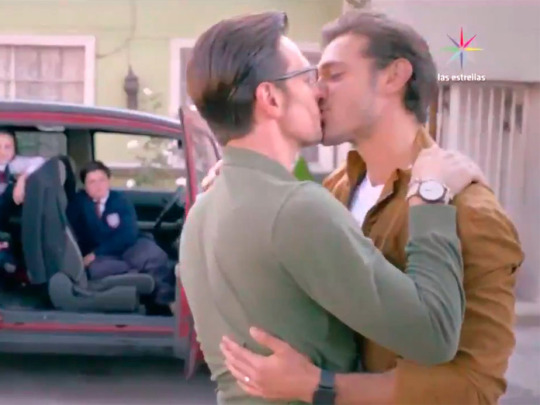
(Two characters share a kiss, while children in the back watch in confusion. A few seconds later the father of the children slams the door close to shield his children from witnessing this “non normal” kiss between his two neighbors.) (Image Retrieved from Google)
In the Brazilian telenovela "Que Pobres Tan Ricos" in 2014, the network Univision prevented for the program to air, due to a gay kiss that was captured in a scene. Three years later, in November 15th of 2017, the same network Univision Mexico ran the first gay kiss through the show "Papá A Toda Madre". This was vital to the breakthrough of these characters because it emulated the relationship of two gay characters in a prime-time television for the first time. Although, corporations and media are being more inclusive, they are still marginalizing and misrepresenting LGBT community to the highest degree. They’re perceived as sissy, girlie, and sassy. This program depicts gay men in a light that further stigmatizes gay men. There is a line in the telenovela, which asks, “¿Quien es la esposa?” (“Who is the wife?”) which goes to show, that there isn’t the same respect for a queer relationship, queer space, overall queerness. Although there is a representation, there is still a stereotypical toxic representation of queer relationship, queer space and queerness overall.
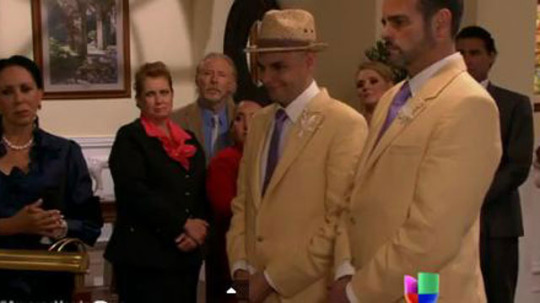
(All gather in celebration of Jean and Estefano’s wedding. All of the people in attendance of this wedding admire the couple, and some even shed tears of joy for the couple. Soon after this, we witness some intimate moments when the couple shares a kiss.) (Image Retrieved from Google)
This is the first gay marriage in a novela and captivates two great examples of the two different types of gay, one can choose to be. The characters In Amores Verdaderos both hold different positions, Jean plays a simple chef, whereas Estefano takes on the image of a masculine guy that aside from his interactions with Jean, shows no feminine gestures. Jean is all over the place and exaggerates all of his emotions and vents/speaks in a way that makes him sound vulnerable. He is but a joke that other characters play off of and can't take seriously making him an accessory to disrespect and use as needed.
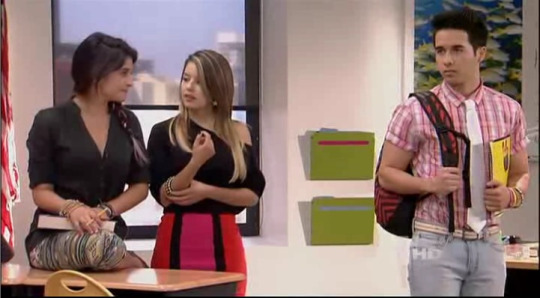
(Saddened because he’s been ridiculed, Alejandro grabs his belonging and stares back with tears in his eyes because of how he’s been bullied for exhibiting girl like characteristics. He’s called a girl because he pays lots of attention to his appearance. He leaves the room and reflects on how he’s rejected after coming out.) (Image Retrieved from Google)
The character Alejandro from Relaciones Peligrosas takes time to find himself and struggles with self acceptance. When he finally has his coming out moment, he becomes that stereotypical image of a gay man. He spends a lot of time being almost an accessory for his best friend and seeks no true relationship. He experiences feelings for a character and is rejected for being flamboyant and out. Other guys acknowledge him as a girl because of how he dresses and cares so much about his appearance. “Presents acceptance by family and friends as the most crucial issues,” this quote captivates how gay characters fall into a role where they are meant to seek the approval of those around them and that might be adjusting who they were to what people expect (Dow, pg.11).
These ideas surrounding “machismo” have been around for so long, and is described as, “Machismo is complex and multifaceted and too often, in Anglo-American interpretations, reduced to self-aggrandizing male bravado that flirts with physical harm to be sexual, like some rutting for the rights to pass on genes”(Coronado). This quote brings on the discussion on how in Latin American culture the acts of being a man are dominated by the hegemonic assumptions on gender. This could range from positions they hold to the role they play with in their environments and what form of position they take around other members of the same sex.
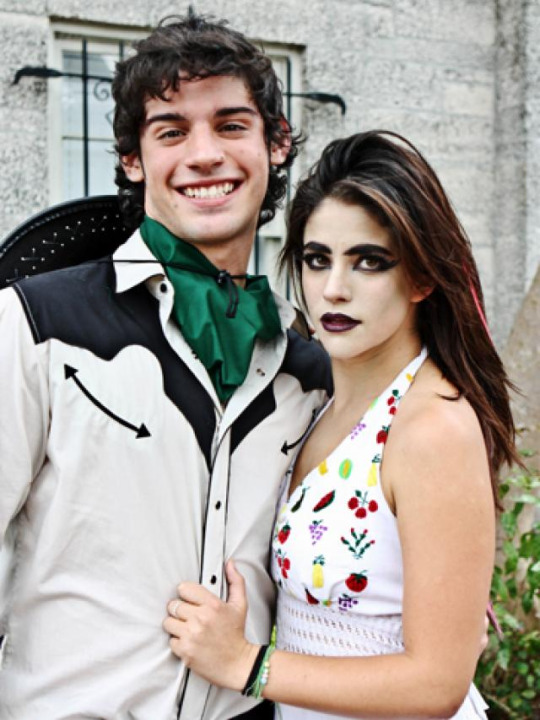
(Diego is seen posing next to Gabriella. Gabriella is the girl who Diego has been having a fake relationship with, in attempts to hide his sexuality.) (Image Retrieved from Google)
When looking at the character Diego in the telenovela named Relaciones Peligrosas, one might notice that he rejects his sexuality and chooses to play the role of a straight man. He is aggressive and can be identified as a bully. He also hopes to follow in his father’s footsteps, in being a doctor. He takes on this persona where he ignores his partner and focuses on work and really any other activity where he is able to look more masculine, such as drinking games and teasing amongst him and his friends. Yet when alone with another gay character he tends to act a little more human.
youtube
(In this scene we see Alejandro a few seconds away from taking pills to cope with how much he’s been bullied about his sexuality. Diego arrives and Alejandro confronts Diego about his indecent actions in concluding that he will not let others especially not Diego, take his power away from him, and kill him by bullying.) (Video Retrieved from Youtube)
After exploring the telenovelas presented, it’s evident that there is a worrisome trend that is very present within Mexican telenovelas. Telenovelas do an amazing job representing love, drama, and comedy, however they continue to misrepresent the queer community—specifically gay Latin men. Though queer representation has increased in Telenovelas, there’s still a prominent pattern of hyper feminization of these gay Latin characters that is harmful because it reinforces false depictions and negative stereotypes. Telenovelas seem to continuously hyper-feminize these characters. Telenovelas also create a sense of machismo in characters which overshadows obstacles, like coming out. Ultimately these two things marginalize and trivialize sexual and gender minorities, sending the wrong message to audiences through Mexico’s largest mainstream media platform, telenovelas.
References
Ciszek, E.L. (2017). Todo Mejora en el Ambiente. Journal of Communication Inquiry 41:4,pages 313-330. Retrieved from http://journals.sagepub.com/doi/10.1177/0196859917712980
Coronado, J. D. (2015). machismo Oxford University Press.doi:10.1093/obo/9780199913701.016.0106
Dow, B. (2001) Ellen, Television, and the Politics of Gay and Lesbian Visibility, Critical Studies in Media Communication, 18:2, 123-140, DOI:10.1080/07393180128077
Rosario "Ro" Flores. (2013, May 23). Retrieved October 15, 2018, from https://www.telemundo.com/series-y-novelas/2013/07/03/rosario-ro-flores
Roth, D. S. (2018, March 21). This is how Spanish-language TV portrays LGBTQ characters, and it's worrisome. Retrieved from https://www.miamiherald.com/news/local/community/gay-south-florida/article206267474.html
Stokes, Z., Trasandes, M., & Quezada, J. (2016). Nearly invisible: LGBTQ representations onSpanish-language television in the United States. GLAAD. Retrieved from http://www.glaad.org/nearly-invisible-casi-invisibles.
Tate, J. (2013). Redefining Mexican masculinity in twenty-first century telenovelas. Hispanic
3 notes
·
View notes